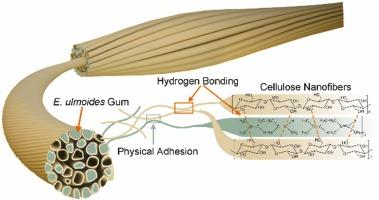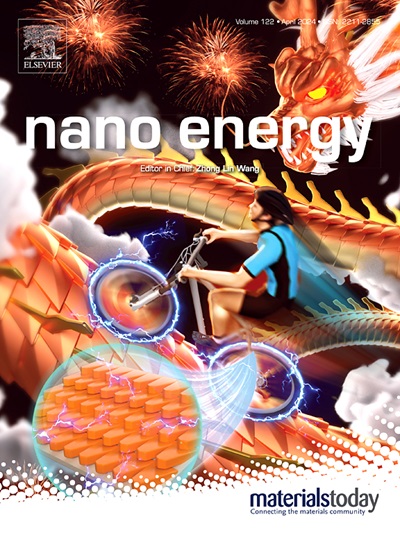Self-Adhesive Ionic Cable Derived from Natural Bark as Osmotic Energy Generator
IF 16.8
1区 材料科学
Q1 CHEMISTRY, PHYSICAL
引用次数: 0
Abstract
Osmotic energy conversion technology plays an increasingly important role as clean energy alternatives. However, the excessive use of non-renewable materials in osmotic energy harvesting can lead to serious environmental pollution. Herein, we design a low-cost, eco-friendly, and high-ion-conductance ionic cable directly from natural Eucommia ulmoides bark owing to its unique sandwich structure and abundant charged nanochannels within the well-aligned lignocellulose nanofibers. In the cable, the natural biopolymer E. ulmoides gum (EUG) acts as a bio-adhesive tightly holding cellulose fibers together, rendering it with high morphological stability. The as-prepared ionic cable shows excellent ion conductance of 3.36×10-3 S cm-1, far surpassing the performance of natural bark (2.58×10-4 S cm-1). This work utilizes the natural E. ulmoides bark components and its unique lignocellulose-EUG sandwich structure to construct fully biomass-based cable with high-ion-conductance and water-stable, providing a sustainable strategy to accelerate the implementation of clean osmotic energy harvesting and forest waste utilization.

从天然树皮中提取的自粘性离子电缆作为渗透能量发生器
作为清洁能源的替代品,渗透能转换技术发挥着越来越重要的作用。然而,过度使用不可再生材料采集渗透能会造成严重的环境污染。在此,我们利用杜仲树皮独特的夹层结构和排列整齐的木质纤维素纳米纤维中丰富的带电纳米通道,直接从天然杜仲树皮中设计出了一种低成本、环保和高离子传导性的离子电缆。在电缆中,天然生物聚合物杜仲胶(EUG)作为生物粘合剂将纤维素纤维紧紧粘在一起,使其具有很高的形态稳定性。制备的离子缆具有 3.36×10-3 S cm-1 的优异离子传导性,远远超过天然树皮(2.58×10-4 S cm-1)。该研究利用天然桉树树皮成分及其独特的木质纤维素-EUG夹层结构,构建了具有高离子传导性和水稳定性的全生物质基电缆,为加速实现清洁渗透能源采集和森林废弃物利用提供了一种可持续发展战略。
本文章由计算机程序翻译,如有差异,请以英文原文为准。
求助全文
约1分钟内获得全文
求助全文
来源期刊

Nano Energy
CHEMISTRY, PHYSICAL-NANOSCIENCE & NANOTECHNOLOGY
CiteScore
30.30
自引率
7.40%
发文量
1207
审稿时长
23 days
期刊介绍:
Nano Energy is a multidisciplinary, rapid-publication forum of original peer-reviewed contributions on the science and engineering of nanomaterials and nanodevices used in all forms of energy harvesting, conversion, storage, utilization and policy. Through its mixture of articles, reviews, communications, research news, and information on key developments, Nano Energy provides a comprehensive coverage of this exciting and dynamic field which joins nanoscience and nanotechnology with energy science. The journal is relevant to all those who are interested in nanomaterials solutions to the energy problem.
Nano Energy publishes original experimental and theoretical research on all aspects of energy-related research which utilizes nanomaterials and nanotechnology. Manuscripts of four types are considered: review articles which inform readers of the latest research and advances in energy science; rapid communications which feature exciting research breakthroughs in the field; full-length articles which report comprehensive research developments; and news and opinions which comment on topical issues or express views on the developments in related fields.
 求助内容:
求助内容: 应助结果提醒方式:
应助结果提醒方式:


